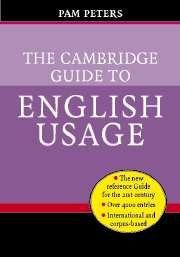Book contents
- Frontmatter
- Contents
- Preface
- Overview of Contents and How to Access Them
- A
- B
- C
- D
- E
- F
- G
- H
- I
- J
- K
- L
- M
- N
- O
- P
- Q
- R
- S
- T
- U
- V
- W
- X
- Y
- Z
- Appendix I International Phonetic Alphabet Symbols for English Sounds
- Appendix II Geological Eras
- Appendix III Perpetual Calendar 1901–2008
- Appendix IV International System of Units (SI Units)
- Appendix V Interconversion Tables for Metric and Imperial Measures
- Appendix VI Selected Proofreading Marks
- Appendix VII Formats and Styles for Letters, Memos and E-mail
- Appendix VIII Layout for Envelopes
- Appendix IX Currencies of the World
- Bibliography
Overview of Contents and How to Access Them
Published online by Cambridge University Press: 26 July 2017
- Frontmatter
- Contents
- Preface
- Overview of Contents and How to Access Them
- A
- B
- C
- D
- E
- F
- G
- H
- I
- J
- K
- L
- M
- N
- O
- P
- Q
- R
- S
- T
- U
- V
- W
- X
- Y
- Z
- Appendix I International Phonetic Alphabet Symbols for English Sounds
- Appendix II Geological Eras
- Appendix III Perpetual Calendar 1901–2008
- Appendix IV International System of Units (SI Units)
- Appendix V Interconversion Tables for Metric and Imperial Measures
- Appendix VI Selected Proofreading Marks
- Appendix VII Formats and Styles for Letters, Memos and E-mail
- Appendix VIII Layout for Envelopes
- Appendix IX Currencies of the World
- Bibliography
Summary
The alphabetical list in this book contains two kinds of entries: those which deal with general topics of language, editing and writing, and those dealing with particular words, word sets or parts of words. An overview of many general entries is provided on the opposite page. The particular entries, focusing on issues of usage, spelling and word form, are too numerous to be shown there, and simply take their places in the alphabetical list. But for many questions, either general or particular entries would lead you to the answer you're seeking, and the book offers multiple access paths via crossreferences.
Let's say you are interested in where to put the full stop in relation to a final bracket or parenthesis. Any of those terms (full stop, bracket, parenthesis) would take you to the relevant discussion under brackets. In addition the general entry on punctuation presents a list of all the entries dealing with individual punctuation marks, for both words and sentences.
Questions of grammar are accessible through traditional terms such as noun and verb, clause and phrase, and traditional labels such as dangling participle or split infinitive… though the entries may lead you on to newer linguistic topics such as information focus and modality. Aspects of writing and argument (when is it OK to use I? what does it mean to beg the question?) are discussed under their particular headings, but can also be tracked down through more general ones such as impersonal writing and argument.
- Type
- Chapter
- Information
- The Cambridge Guide to English Usage , pp. x - xiiPublisher: Cambridge University PressPrint publication year: 2004



